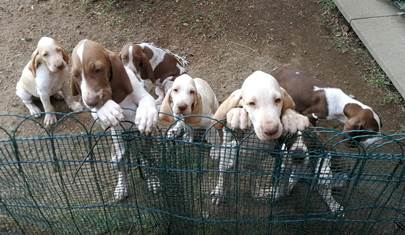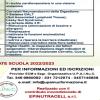 Share on Facebook
Share on Facebook
For Information, please call +39 3483149436
 Puppies
Puppies
Bracco Italiano dogs tend to give birth to litters of 3 to 8 puppies. As puppies, this breed loves to romp and play – they can also be quite curious. If you intend to use your dog for hunting, it is best to start as early as possible. This is also the case with obedience training – the breed is very intelligent and highly trainable so there is no reason not to start early. Early socialization is also important to ensure that your dog remains friendly around people as well as other dogs and pets.

The most suitable truffle hunting dog
Some dog types are indeed more suitable than others: Italian Pointer (bracco Italiano) stand out for his incredibly developed sense of smell and his physical prowess. In any case, the most important things are training, which begins when the dogs are still puppies, and the level of understanding established between dog and man.
 Bracco Italiano Basics
Bracco Italiano Basics
Also known as the Italian Pointer, the Bracco Italiano is proud, athletic gun dog. With their strong muscles and long ears, it is easy to see why these dogs are the pride of Italy. Though this breed was originally developed for hunting, their gentle temperament makes them excellent family pets as well. Their droopy lips, soft eyes and loving nature makes them a great pet for any family.
Also known as the Italian Pointer, the Bracco Italiano is proud, athletic gun dog.
 Origin
Origin
The Bracco Italiano breed is generally considered to be one of the classic pointer breeds, present since the Middle Ages. During the Renaissance period, the popularity of this breed spread rapidly among nobility who came to value its skill in hunting feathered game. Though originally used for bird hunting, the Bracco Italiano is a versatile breed that has adapted well to modern hunting methods.
Currently there are two different variations of the breed – the Piedmontese Pointer and the Lombard Pointer. As suggested by its name, the Piedmontese Pointer originated in Piedmont and it is known for its lighter color and build. These dogs typically exhibit a white-and-orange coloration. Both variations became nearly extinct during the early 20th century but the breed was saved by the efforts of a few Italian breeders who dedicated themselves to preserving the breed. The standard for the breed was released by the Societa Amatori Bracco Italiano in 1949 and the breed was introduced to England forty years later in 1989.
 Pedigree
Pedigree
The exact origins of the breed are unknown but it is thought that the Bracco Italiano may be a cross between the Segugio Italiano (an Italian coursing hound) and the Asiatic Mastiff.
Food/Diet
Given the size of this breed, a high-quality large-breed dog food formula is recommended. If you plan to train your dog for hunting or if he leads an otherwise active lifestyle, choose a dog food formulated for active dogs that will provide for his energy needs.
The Bracco Italiano is a highly intelligent breed which is one of the many features that makes it a great hunting dog.
 Training
Training
The Bracco Italiano is a highly intelligent breed which is one of the many features that makes it a great hunting dog. Not only does this dog have great hunting instincts, but he is naturally eager to please. The best training methods for this dog are gentle but consistent – the gentle nature of this dog may make him stop trying if he is treated with harshness or cruelty. For the best results, use positive reinforcement training and start obedience training from a young age.
Many fans of the breed will argue that a Bracco Italiano that is not trained to hunt will not be a happy dog. Not only is this the activity the breed was meant for, but the dogs truly enjoy the activity. Even if you choose not to train your dog for hunting, you should provide him with plenty of mental exercise in addition to physical exercise to keep him sharp.
 Weight
Weight
The average weight of an adult Bracco Italiano ranges between 55 and 88 pounds. Females of the breed are slightly smaller than the males.
Temperament/Behavior
Though the breed originated as a hunting dog, the Bracco Italiano actually makes a wonderful family pet. His gentle, people-loving nature makes him an excellent companion pet and his patience enables him to get along well with even young children. This breed tends to get along well with other dogs and, if introduced at a young age, even with cats and other pets. This breed is eager to please so, as long as they are treated with kindness, they will be obedient. The Bracco Italiano will bark when strangers come to the house, but they are too gentle to make very effective guard dogs.
Life Expectancy
The average life expectancy of this breed is between 12 and 15 years
 Exercise Requirements
Exercise Requirements
As a hunting breed, the Bracco Italiano likes to be fairly active but they can do well in an apartment or house without a yard if given adequate exercise. A nice 30-minute walk once a day will be adequate for this breed, though he will gladly accept more exercise. The Bracco Italiano has a unique gait that you may see if you give him a chance to run – he starts out at a slow trot with long strides but is capable of a fast gallops. When hunting, the Bracco Italiano reduces his speed the closer he gets to his quarry, coming to a near crawl and ending in a non-moving “point”.
Though the breed originated as a hunting dog, the Bracco Italiano actually makes a wonderful family pet.
 AKC
AKC
The Bracco Italiano has yet to be officially recognized by the AKC. Currently, the breed is in the Foundation Stock Service Program – once the number of registered Bracco Italiano dogs in the U.S. reaches 150, the breed will be fully accepted by the AKC.
Coat
As a hunting breed that spends a lot of time running through brush and grassland, the Bracco Italiano has a very short and dense coat. The texture of the breed’s coat is fairly rough but with a good sheen – the fur may be softer on the head, throat, ears and legs. There two most common color combinations, white-orange and roano-brown – chestnut or amber-colored patches are also allowed on the face, ears, tail and body. The Bracco Italiano standard indicates that any black on the coat is a fault.



